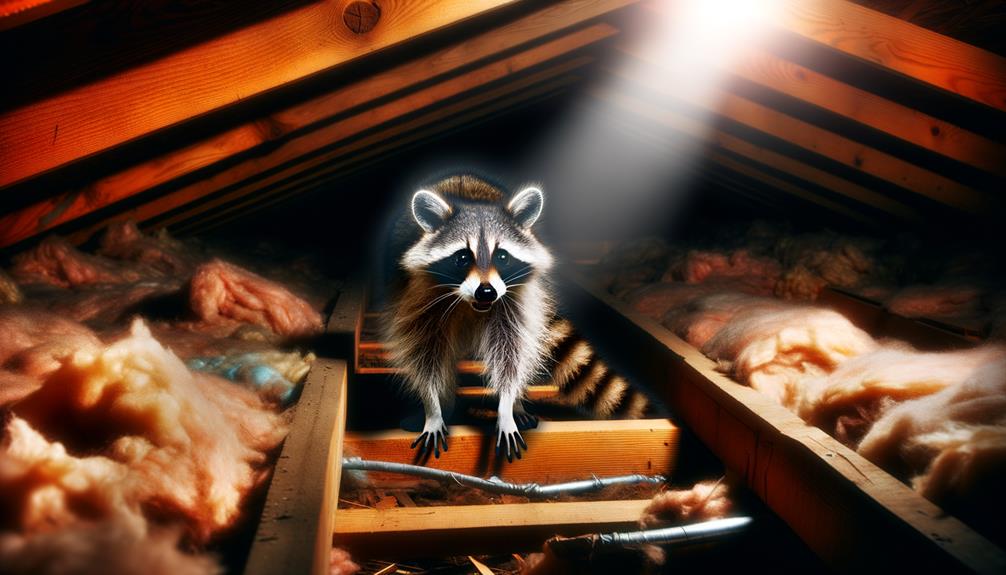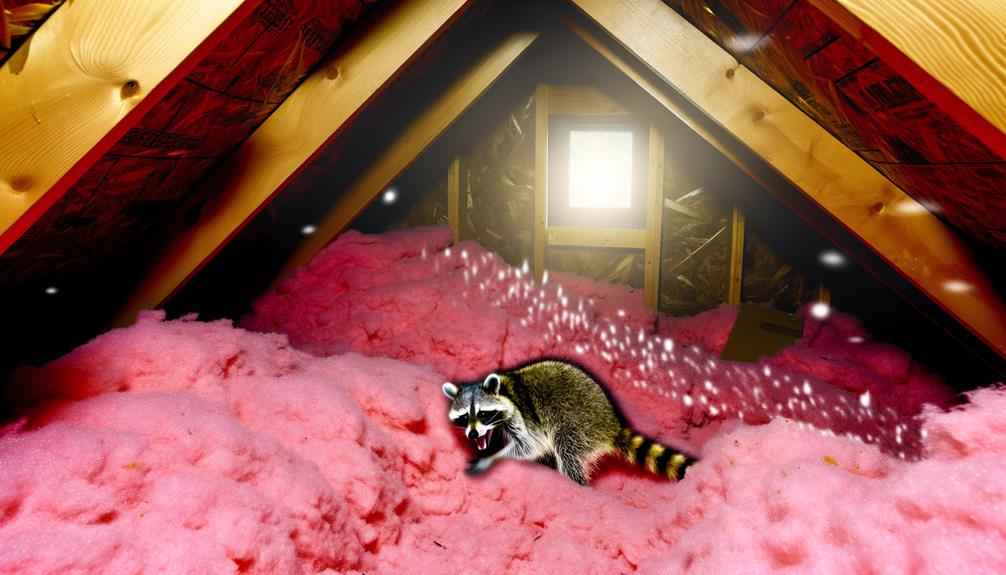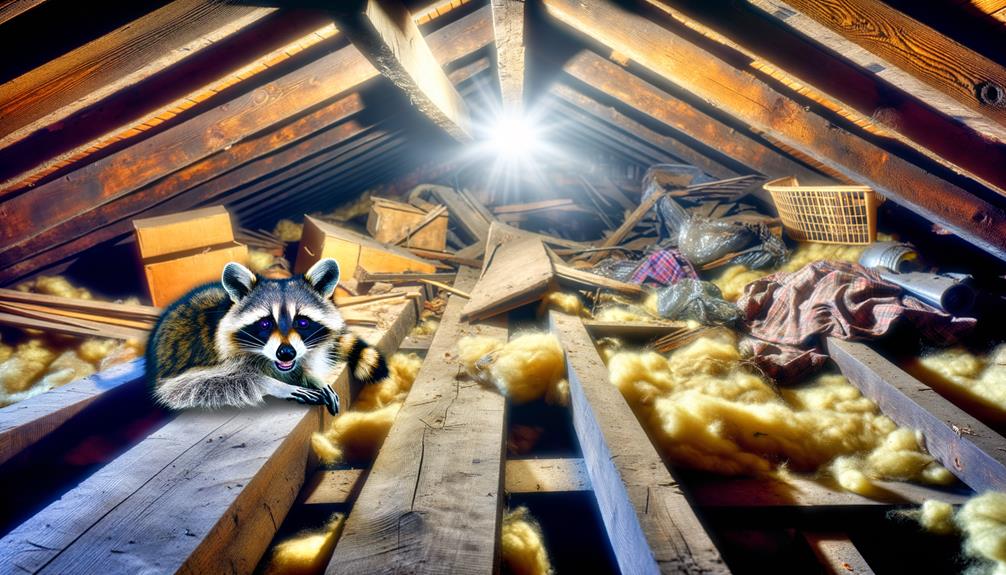How to Determine if Raccoons Can Live in Your Hot Attic
Raccoons can tolerate moderate heat, employing behavioral and physiological strategies to manage thermal stress. They seek cooler, shaded areas within attics, utilize sweat glands on their paws, and avoid daytime heat through nocturnal activity.
However, attic temperatures can exceed 50°C (122°F) in summer, posing significant health risks such as dehydration and heat stress. This excessive heat, combined with poor ventilation, can also lead to respiratory issues and parasitic infections.
Identifying signs of raccoon presence early, such as nocturnal noises or droppings, and implementing preventive measures is essential for both structural integrity and raccoon health. For more detailed insights, continue exploring further.

Key Takeaways
- Raccoons can tolerate temperatures up to 35°C (95°F) by using behavioral and physiological adaptations.
- Attic temperatures can exceed 50°C (122°F) in summer, posing severe risks to raccoons' health.
- Raccoons seek cooler, shaded areas within the attic to manage extreme heat.
- Proper hydration and reduced activity levels help raccoons survive high temperatures.
- Effective ventilation and temperature regulation are crucial for raccoon health in attics.
Raccoon Heat Tolerance

Raccoons exhibit a moderate level of heat tolerance, enabling them to survive in environments with elevated temperatures. This adaptability is facilitated by their ability to regulate body temperature through behavioral and physiological mechanisms.
Studies indicate that raccoons can remain active and forage for food in temperatures up to 35°C (95°F), but prolonged exposure to extreme heat can lead to hyperthermia. Their semi-arboreal nature allows them to seek shaded, cooler areas during peak heat periods.
Moreover, raccoons possess sweat glands on their paws, aiding in thermoregulation. However, their fur, while providing insulation in colder climates, can become a liability in excessively hot environments, necessitating access to cooler refuges to prevent overheating.
Attic Temperatures in Summer
Given their moderate heat tolerance, it is important to understand that attic temperatures in summer can vastly exceed outdoor temperatures, often reaching and surpassing 50°C (122°F).
This extreme heat is primarily due to solar radiation absorbed by roofing materials and limited ventilation within attic spaces. Studies indicate that poorly insulated attics can experience temperature spikes that are 30-40% higher than ambient outdoor conditions. The lack of airflow exacerbates this issue, creating a heat-trap effect.
Thermal imaging data confirm that peak attic temperatures typically occur in mid-afternoon, aligning with the highest external temperatures. Such conditions pose significant thermal stress, affecting both the structural integrity of the attic and the viability of any inhabitants, including raccoons.
Behavioral Adaptations

To cope with the extreme heat of attic environments, raccoons exhibit several behavioral adaptations that enhance their chances of survival. Primarily, raccoons are nocturnal, reducing their exposure to peak daytime temperatures.
Studies have shown that raccoons will seek shaded, cooler areas within the attic, such as beneath insulation or in corners with minimal sunlight exposure. Additionally, they increase their hydration by seeking out water sources more frequently, as dehydration is a critical risk.
Behavioral observations indicate that raccoons will also reduce their activity levels during the hottest periods to conserve energy and minimize heat production. These strategies collectively enable raccoons to manage the thermal stress associated with attic living during the summer months effectively.
Health Risks for Raccoons
Exposure to the elevated temperatures in an attic can pose significant health risks for raccoons. These risks include dehydration and heat stress, which can severely impact their physiological functions.
Additionally, raccoons in such environments are prone to respiratory issues and an increased likelihood of parasitic infections.
Dehydration and Heat Stress
Raccoons residing in hot attics are at significant risk of dehydration and heat stress due to their inability to effectively regulate their body temperature in extreme conditions. These environments can reach temperatures exceeding 120°F, well beyond the thermoneutral zone for raccoons, typically between 50°F and 80°F.
Prolonged exposure to such heat can lead to hyperthermia, where body temperatures rise dangerously high. Dehydration ensues as raccoons lose water through panting and increased respiration rates, exacerbating the risk of heat stress. Clinical signs include lethargy, rapid breathing, and, in severe cases, organ failure.
Data indicates that without intervention, raccoons in these conditions face significant morbidity and mortality, highlighting the urgent need for preventive measures in attic spaces.
Respiratory Issues
High temperatures in attic spaces can exacerbate respiratory issues in raccoons, leading to increased susceptibility to respiratory infections and other pulmonary complications. Data indicate that raccoons exposed to prolonged heat stress may experience inflammation of the respiratory tract, which impairs their ability to efficiently exchange gases.
Elevated temperatures can also foster the growth of harmful microorganisms, increasing the risk of infection. Moreover, the combination of heat and poor air circulation in attics can lead to a significant decline in air quality, contributing to respiratory distress.
Studies have shown that raccoons in such environments exhibit higher incidences of symptoms like coughing, wheezing, and labored breathing, highlighting the critical need for proper ventilation and temperature regulation in attic spaces.
Parasitic Infections
Inhabitants of attic spaces are at heightened risk of parasitic infections, which can greatly impact the health and well-being of raccoons. Limited ventilation and the accumulation of organic debris create an ideal environment for parasites to thrive.
Notable parasitic infections in raccoons include:
- Baylisascaris procyonis: This intestinal parasite can cause severe neurological damage in raccoons and is zoonotic, posing a risk to humans.
- Sarcoptes scabiei: Infestation leads to intense itching, hair loss, and secondary infections due to skin lesions.
- Ectoparasites: Fleas and ticks can transmit other pathogens, exacerbating health issues.
Addressing these parasitic threats is essential to maintaining raccoon health in attic environments.
Signs of Raccoons in Attic

Identifying raccoons in an attic can be systematically approached by monitoring for specific indicators. Nocturnal activity noises, such as scratching and thumping, are common auditory signs. Droppings and distinct odors provide olfactory evidence. Additionally, visible damage to insulation material often correlates with raccoon habitation.
Nocturnal Activity Noises
Nocturnal activity noises, such as scratching, thumping, and chattering, are strong indicators of raccoons inhabiting an attic space. These sounds generally occur during the night, aligning with raccoons' nocturnal behavior. Homeowners may observe:
- Scratching: Raccoons use their claws to navigate surfaces, which often produces a distinct scratching sound.
- Thumping: The weight and movement of raccoons can cause audible thumps, particularly when they move quickly.
- Chattering: Raccoons communicate through vocalizations, including chattering, growling, and whimpering.
These nocturnal noises often peak during the breeding season when raccoons are particularly active. Identifying these auditory cues is essential for early detection and effective wildlife management, ensuring prompt intervention to prevent potential structural damage and health risks.
Droppings and Odors
The presence of raccoon droppings and strong, musky odors in an attic are definitive indicators of raccoon infestation.
Raccoon droppings, typically dark and tubular, can often be found in clustered latrine areas within the attic. These droppings pose significant health risks, as they can harbor pathogens such as Baylisascaris procyonis, a parasitic roundworm.
The musky odor, attributed to raccoon urine and scent-marking, becomes especially pronounced in confined attic spaces. Such odors not only signify ongoing infestation but also contribute to long-term structural and material damage due to their corrosive nature.
Quantitative data indicate high levels of ammonia and other volatile compounds in raccoon urine, underscoring the necessity for prompt identification and remediation of these signs.
Insulation Damage Evidence
Observable evidence of insulation damage often signifies the presence of raccoons in an attic, with shredded material and displaced insulation being primary indicators. Raccoons tend to create nests within the insulation, disrupting its uniformity and effectiveness. This activity can lead to increased energy costs and reduced thermal efficiency.
The following signs are commonly observed:
- Torn Insulation: Raccoons tear apart insulation to create nesting spaces, leaving behind visible damage.
- Movement: Insulation may be shifted or compacted in specific areas, indicating frequent raccoon traffic.
- Waste and Urine Stains: Biological waste products can stain and degrade insulation, contributing to poor air quality.
Identifying these signs early can help mitigate further damage and guarantee timely removal of the animals.
Impact on Home Structure
Raccoons inhabiting an attic can cause significant structural damage, including compromised insulation, chewed electrical wiring, and weakened support beams. Studies indicate that raccoons often tear apart insulation to create nesting sites, leading to decreased energy efficiency and increased utility costs.
Chewing on electrical wiring, a behavior observed in 70% of raccoon infestations, poses substantial fire hazards. Structural integrity is further jeopardized by raccoons gnawing on wooden support beams, which can result in costly repairs. Furthermore, raccoon urine and feces contribute to wood rot and mold proliferation, exacerbating the damage.
These impacts necessitate immediate attention and remediation to maintain the safety and functionality of the home structure. Quantitative data underscores the urgency of addressing raccoon infestations promptly.
Preventing Raccoon Infestations

Implementing effective prevention strategies is imperative to mitigate the risk of raccoon infestations in attics. Research indicates that raccoons are skilled at exploiting structural weaknesses in homes. To prevent these intrusions, homeowners should focus on sealing potential entry points and maintaining a secure environment.
Data suggests that robust prevention methods can decrease infestation risks by up to 80%. Key strategies include:
- Securing Chimneys and Vents: Install mesh covers to prevent raccoons from accessing these entry points.
- Repairing Roof Damage: Address any structural damage, such as broken shingles or gaps, to eliminate access routes.
- Proper Waste Management: Make sure that garbage bins are tightly sealed and not easily accessible to raccoons.
Adopting these measures can greatly reduce the likelihood of raccoon infestations.
Safe Removal Techniques
Effective elimination of raccoons from attics necessitates employing humane and scientifically validated techniques to guarantee both the safety of the animals and the integrity of the home.
Trapping, using exclusion devices, and employing deterrents are primary methods. Live traps, compliant with wildlife regulations, should be checked regularly to minimize raccoon distress. Exclusion devices, such as one-way doors, allow raccoons to exit but prevent re-entry. Utilizing deterrents like bright lights or loud noises can encourage raccoons to vacate the attic voluntarily.
Data indicate that combining these approaches optimizes success rates. Additionally, sealing entry points post-removal is crucial to prevent re-infestation. Following these evidence-based methods ensures raccoon removal is effective, ethical, and minimally disruptive to the attic environment.
Professional Help Options

For homeowners facing raccoon infestations, consulting with professional wildlife removal services can provide expert solutions that are both humane and efficient. These specialists employ scientifically-backed methods to make sure the safe extraction and relocation of raccoons, which can prevent potential health hazards and structural damage in your home. Data indicates that professional interventions are much more effective than DIY approaches, reducing recurrence rates significantly.
Key benefits include:
- Expertise: Technicians are trained in identifying entry points and animal behavior.
- Safety: Professionals use equipment and methods that minimize risk to both humans and animals.
- Preventative Measures: Services often include sealing entry points and advising on future prevention.
This professional approach ensures a thorough resolution to raccoon-related issues in your attic.
Conclusion
The ability of raccoons to survive in hot attics is severely constrained by their heat tolerance and the elevated temperatures found in such spaces during summer months. Behavioral adaptations may provide limited relief, but significant health risks remain.
The presence of raccoons can damage home structures and pose further complications. What measures can be taken to mitigate these issues? Effective prevention, safe removal techniques, and professional intervention are paramount in addressing raccoon infestations.






